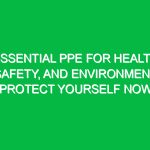Introduction
In the realm of Health, Safety, and Environment (HSE), understanding what pressures exist is crucial for fostering safe and sustainable workplaces. The concept of pressure in HSE transcends mere physical forces; it encapsulates various stressors that can impact worker Safety, environmental integrity, and organizational compliance. This article delves into the multifaceted pressures inherent in the HSE domain, examining how they manifest in real-world scenarios and offering insights into Best Practices for managing them.
What are pressures in HSE? At its core, these pressures include regulatory obligations, organizational culture, physical and psychological stressors, and the external environment’s demands. Each aspect contributes to a complex web of challenges that organizations must navigate to ensure compliance and safeguard their employees’ health and wellbeing.
Drawing from both theoretical frameworks and practical experiences, we will explore the different dimensions of these pressures, highlighting their implications and offering actionable recommendations.
Understanding Pressures in HSE
1. Regulatory Pressures
Regulatory pressures are perhaps the most visible type of pressure in HSE. Organizations must comply with a patchwork of laws and Regulations, which can vary significantly across different regions and industries.
- Compliance with Local and International Standards: Organizations are often required to adhere to standards such as ISO 45001 for Occupational Health and Safety and ISO 14001 for environmental management. Non-compliance can result in hefty fines, legal repercussions, and reputational damage.
- Continuous Monitoring and Reporting: Many regulations mandate regular reporting and monitoring of health and safety metrics. This can create pressure on organizations to maintain meticulous records and ensure that safety protocols are consistently followed.
- Adapting to Changes: Regulatory landscapes are dynamic and often subject to change. Companies must stay abreast of these changes and adapt their practices accordingly, which can be resource-intensive.
2. Organizational Culture Pressures
The culture within an organization can significantly influence its HSE practices. A strong safety culture promotes a proactive approach to identifying and mitigating risks, whereas a weak culture can lead to negligence and complacency.
- Leadership Commitment: The commitment of leadership to health and safety can set the tone for the entire organization. If leaders prioritize safety, employees are more likely to follow suit.
- Employee Engagement: Engaging employees in HSE practices fosters a sense of ownership and responsibility. Conversely, a lack of engagement can lead to pressures that result in unsafe practices.
- Incentive Structures: Organizations that reward safety compliance and proactive behavior can reduce pressures associated with workplace accidents and injuries. However, if rewards are tied solely to production or output, it may create a disconnect that prioritizes performance over safety.
3. Physical and Psychological Pressures
Both physical and psychological pressures play vital roles in the HSE context.
- Workplace Environment: Physical pressures can stem from inadequate Safety Measures, such as insufficient Personal Protective Equipment (PPE) or poorly maintained equipment. These factors can lead to accidents and injuries, posing significant risks to workers.
- Workload and Stress: High workloads and time constraints can create immense psychological pressure, leading to burnout and decreased focus on safety practices. This is particularly relevant in high-stakes industries such as construction and healthcare.
- Fatigue Management: Addressing fatigue is essential in maintaining worker safety. Organizations must implement measures to manage fatigue, including shift rotations and mandated rest periods.
4. External Environmental Pressures
The external environment poses pressures that organizations must navigate effectively.
- Climate Change: Increasingly erratic weather patterns and climate concerns compel organizations to adapt their practices to mitigate environmental impact, which can create operational pressures.
- Public Perception: In today’s interconnected world, public scrutiny of corporate practices is at an all-time high. Organizations are under pressure to demonstrate their commitment to Sustainability and ethical practices.
- Market Competition: Competitive industries may pressure organizations to cut corners on safety to reduce costs, which can lead to significant risks and liabilities.
Best Practices for Managing HSE Pressures
Managing the various pressures associated with HSE requires strategic planning and proactive measures. Here are several Best Practices organizations can implement:
1. Develop a Robust HSE Management System
An effective HSE management system provides a structured approach to managing health and safety risks. This includes identifying Hazards, assessing risks, implementing Control Measures, and monitoring performance. Utilizing frameworks such as Plan-Do-Check-Act (PDCA) can facilitate continuous improvement.
2. Foster a Positive Safety Culture
Investing in a culture of safety can significantly reduce pressures related to compliance and risk management. Organizations can achieve this by:
- Encouraging open communication about safety concerns.
- Recognizing and rewarding safe behavior among employees.
- Providing ongoing Training and resources to promote awareness and competency.
3. Engage Employees in HSE Practices
Involving employees in the development and implementation of safety practices can enhance commitment and ownership. Regular safety meetings, feedback sessions, and training workshops can empower employees to take an active role in safeguarding their wellbeing.
4. Regularly Review and Audit HSE Practices
Conducting regular audits and reviews of HSE practices can help organizations identify areas for improvement and ensure compliance with regulations. This proactive approach can mitigate potential risks and reinforce a culture of continuous improvement.
5. Utilize Technology and Innovation
Advancements in technology can streamline HSE processes and reduce pressures. For example, utilizing data analytics can help organizations identify patterns in incidents and near misses, enabling more effective risk management. Additionally, wearable technology can monitor worker health and safety in real-time.
Real-Life Examples of HSE Pressures
To illustrate the impact of pressures in HSE, consider the case of a manufacturing plant that faced significant regulatory scrutiny due to recurring safety violations.
The plant had been cited multiple times for failing to comply with OSHA regulations, leading to a comprehensive review of its safety practices. This pressure forced the organization to overhaul its safety protocols, invest in training, and implement a robust safety management system. As a result, not only did compliance improve, but employee morale also increased as workers felt safer and more valued.
Another example can be drawn from the construction industry, where the pressures of tight deadlines can compromise safety. A construction firm that implemented a fatigue management program saw a marked decrease in accidents. By recognizing the pressure workers faced from long hours, the firm prioritized rest and recuperation, leading to enhanced productivity without sacrificing safety.
Regulations and Standards Governing HSE Pressures
Numerous regulations and standards govern HSE practices, each addressing various aspects of Workplace Safety and environmental management. Understanding these regulations is paramount for organizations striving to navigate the pressures associated with compliance.
- Occupational Safety and Health Administration (osha): OSHA sets and enforces safety standards in the workplace. Compliance with OSHA regulations is a critical pressure for many industries, ensuring that organizations prioritize worker safety.
- Environmental Protection Agency (EPA): The EPA regulates environmental practices, compelling organizations to adhere to standards that protect air and water quality. Non-compliance can lead to severe penalties and public backlash.
- ISO Standards: International standards such as ISO 45001 and ISO 14001 provide frameworks for occupational health and safety and environmental management, respectively. Adopting these standards can help organizations better manage pressures related to compliance and continuous improvement.
Conclusion
Understanding what pressures exist in the Health, Safety, and Environment domain is essential for organizations seeking to foster a safe and compliant workplace. Regulatory, organizational, physical, psychological, and external environmental pressures all play significant roles in shaping HSE practices.
By implementing best practices such as developing a robust HSE management system, fostering a positive safety culture, and engaging employees, organizations can effectively manage these pressures. Moreover, staying informed about regulations and standards ensures compliance and promotes a culture of safety and sustainability.
Ultimately, the goal is to create an environment where health, safety, and environmental integrity are prioritized, leading to improved outcomes for employees, organizations, and the communities they serve. As pressures evolve, so too must our approaches to HSE, ensuring that we remain vigilant and proactive in safeguarding the wellbeing of all stakeholders.


